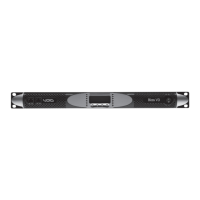10.4.2 Daisy chain with redundant AES3
A slightly more robust network with respect to the audio sys-
tem is the one illustrated in FIGURE 42 and FIGURE 43.
Two amplifiers, the first and the last one in the chain, are set
to work in forward mode. The remaining amplifiers are set to
work in repeater mode.
Even if both the leading and the trailing amplifier forward the
AES3 stream through the AESOP, there is no risk of data col-
lision; furthermore, all amplifiers are capable to switch in real
time to the best signal source in case of connection failures.
This configuration implies the use of an AES3 patch bay in
order to feed with the same digital signal the leading and trail-
ing amplifiers.
Thanks to the auto-sync features implemented in Bias Series
amplifiers, no synchronization mismatch occur between the
two AES3 streams.
Failure cases:
• damaged AESOP connection between amp n and n+1:
Ethernet network connection would be interrupted but
not the audio stream. The audio continuity is preserved
thanks to the real-time switch of the AESOP stream
toward the uncorrupted source coming from the trailing
amplifier. The amplifier n+1 and the following lose the data
connectivity.
• damaged AES3 input connection: no sound interruption
would be heard because the failured input is immediately
replaced by the AESOP stream. Ethernet connectivity is
not affected by this kind of failure.
The robustness of this network is guaranteed for AES3 signals
only, and for a single cable failure at a time (one degree of
redundancy). If two or more connections should fail, one or
more amplifiers (depending on where the interruption occurs)
would be muted.
10.4.3 Daisy chain with AES3 and Ethernet redun-
dancy
Similarly to the previous schema, both AES3 and Ethernet
connection are fed to the leading and the trailing amplifiers in
the daisy chain network.
The AESOP protocol can handle data conflict and manage
real-time witching to a safe signal and/or data source.
This configuration implies the use of an AES3 patch bay and
an ethernet switch.
AESOP
AES3-A stream
Control data stream
Port 1
(primary)
Port 2
(primary)
XLR
AES3
AES3
source
Network
data input
Port 3
(secondary)
Port 4
(secondary)
Port 1
(primary)
Port 2
(primary)
XLR
AES3
Port 3
(secondary)
Port 4
(secondary)
Port 1
(primary)
Port 2
(primary)
XLR
AES3
Port 3
(secondary)
Port 4
(secondary)
Port 1
(primary)
Port 2
(primary)
XLR
AES3
Port 3
(secondary)
Port 4
(secondary)
Audio
Audio + Data
Audio + Data
Audio + Data
Data
Repeat AES3-A
from PORT 2 to PORT 1
Repeat AES3-A
from PORT 2 to PORT 1
Repeat AES3-A
from PORT 2 to PORT 1
Forward to AES3-A
1
2
3
4
FIGURE 41: Daisy chain with AES3
redundancy - four port models.
AESOP
AES3-A stream
Control data stream
XLR
AES3
AES3
source
Network
data input
Port 1
(primary)
Port 2
(primary)
XLR
AES3
XLR
AES3
XLR
AES3
Port 1
(primary)
Port 2
(primary)
Port 1
(primary)
Port 2
(primary)
Port 1

